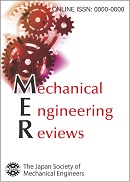Volume 2, Issue 1
Displaying 1-7 of 7 articles from this issue
- |<
- <
- 1
- >
- >|
-
2015 Volume 2 Issue 1 Pages 14-00214
Published: 2015
Released on J-STAGE: January 01, 2015
Advance online publication: December 05, 2014Download PDF (931K) -
2015 Volume 2 Issue 1 Pages 14-00192
Published: 2015
Released on J-STAGE: January 01, 2015
Advance online publication: December 05, 2014Download PDF (1160K) -
2015 Volume 2 Issue 1 Pages 14-00226
Published: 2015
Released on J-STAGE: January 01, 2015
Advance online publication: December 05, 2014Download PDF (1670K) -
2015 Volume 2 Issue 1 Pages 14-00320
Published: 2015
Released on J-STAGE: January 01, 2015
Advance online publication: December 05, 2014Download PDF (10804K) -
2015 Volume 2 Issue 1 Pages 14-00343
Published: 2015
Released on J-STAGE: January 01, 2015
Advance online publication: December 05, 2014Download PDF (4804K) -
2015 Volume 2 Issue 1 Pages 14-00425
Published: 2015
Released on J-STAGE: January 01, 2015
Advance online publication: December 05, 2014Download PDF (5675K) -
2015 Volume 2 Issue 1 Pages 14-00368
Published: 2015
Released on J-STAGE: January 01, 2015
Advance online publication: December 19, 2014Download PDF (2995K)
- |<
- <
- 1
- >
- >|
